The history of Persian pottery dates back to the 7th millennium BCE, the early Neolithic Age. It was the age of the development of agriculture and mankind learned that by cooking clay he can make cooking utensils and that is when the art of pottery was born. In that era, the lower class used pottery cooking utensils, whereas the upper class and aristocrats used dishes made of gold, silver, copper, or brass(Persian art).

What is the Difference between Persian Pottery and Ceramic Utensils?
Ceramic, as a general term, refers to all the items made from materials that are heated at high temperatures to the degree that their initial structure has completely changed. Pottery refers to containers made of clay. Therefore, pottery dishes refer to a subcategory of ceramic dishes.
The following qualities describe a technically made pottery dish:
- The dish has the same level of thickness in all areas.
- The dish is put inside a clay slurry to create a smooth surface.
- The dish is made on a pottery wheel .
- In making pottery dishes manganese oxide and iron oxide are used when the potters want to create a black or
- dark brown color when it is cooked for the second time.
- For the mass production of pottery dishes, baked clay molds are used.
- The glaze was incorporated into pottery dishes.
The History of Persian Pottery Dishes
The oldest Persian pottery dishes ever discovered are cave pottery dishes that belong to the Neolithic era. This type of pottery dish is hand-made, has a rough surface, and is mostly brown.

The art of pottery in Iran goes through five stages:
- First Age: The Temporary Establishment Era
- Second Age: The Permanent Establishment Era
- Third Age: Middle Plateau Era
- Fourth Age: The Historical or Urbanization Era
- Fifth Age: The Islamic Era

The first three eras are called pre-historical eras. Multiple pottery utensils have been discovered from each of these eras that reflect the cultural and historical background of that period.
The First Pottery Age: the Temporary Establishment Era
One of the most significant pottery artifacts that have been discovered in the Western province of Iran, Kermanshah, is the “Venus of Sarab” sculpture. This sculpture is a symbol of fertility and dates back to 6000 B.C.
The Second Pottery Age: The Permanent Establishment Era
This stage coincides with the era when people decided to permanently stay and live in the rural areas and countryside. They were dependent on the land to produce their livelihood and help maintain their livestock.
That is why they relied on the earth and the land itself to provide them with the utensils they needed as well.
People in that era had much appreciation for the land and all it provided for them and they showcased their appreciation in the forms of the patterns they created on their pottery dishes.
The pottery dishes that have been discovered in Teppe Zagheh or Zagheh Hill that is located near Qazvin belong to the second pottery age, which is classified into three main categories:
I. Simple Zagheh Pottery Dishes
II. Painted Zagheh Pottery Dishes
III. Special Zagheh Pottery Dishes

The pottery dishes that belong to this era have a smooth surface and are mostly red. These pottery dishes date back to the late 6th millennium B.C. Other pottery utensils that have been discovered in this area have geometrical shapes.
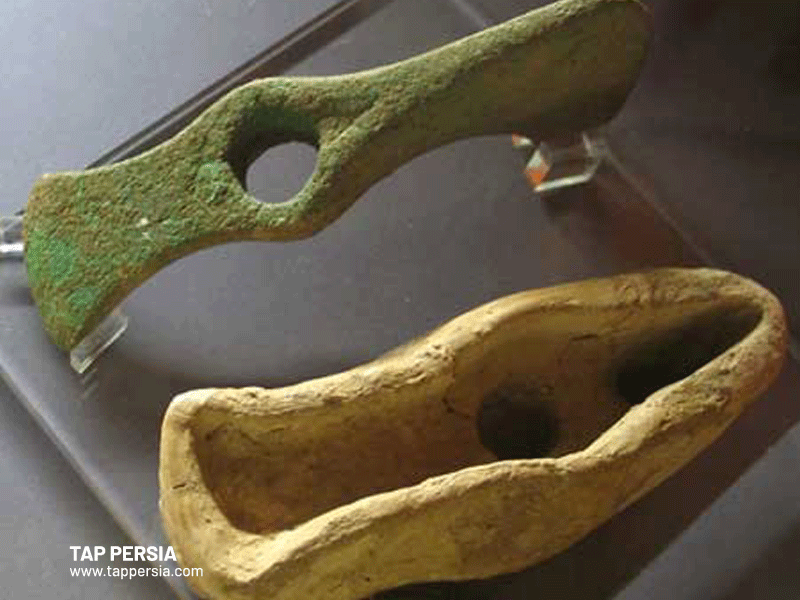
The Third Pottery Age: Middle Plateau Era
The most significant aspect of this era was the use of the pottery wheel. The patterns on the dishes enjoy more variety and they are painted in black on the surface of the dishes. The patterns depict a wide array of things, including geometrical shapes, animals, plants, human beings, and everyday life events including celebrations and dance rituals.
The pottery dishes that have been discovered in Teppe Mousian or Mousian Hill in Susa, an ancient city in the lower Zagros Mountains in Iran, that date back to 3500 to 2500 B.C. belong to this era. One of the most significant pottery dishes that have been excavated in Susa and belong to this era is “The Bushel with Ibex Motifs”.
The Bushel with Ibex Motifs is one of the earliest examples of using ‘animal style’ in painting pottery dishes. The most notable animal motif in this pottery dish is the ibex, a mountain goat, which had a habitat in the Susa region.

The Fourth Pottery Age: The Historical or Urbanization Era
This era is marked by the emergence of grey pottery dishes which in 3000 B.C. replaced the red and brown pottery dishes. Traditionally, grey pottery is known as “Aryan Immigrants’ Pottery” since it soon dominated the entire region of the Iran Plateau. Its emergence marks significant developments in the lifestyle of people in the region.
At the begging of the fourth pottery age, civilization has developed in the southern areas of Iran, and regions such as Susa and Iylam were completely civilized by then. The developments in the Bronze and later Iron Ages advanced the art of pottery making to a great deal which resulted in beautiful pottery artifacts. The most significant grey pottery dishes have been discovered in Teppe Hasanlou or Hasanlou Hill in the north of Iran.
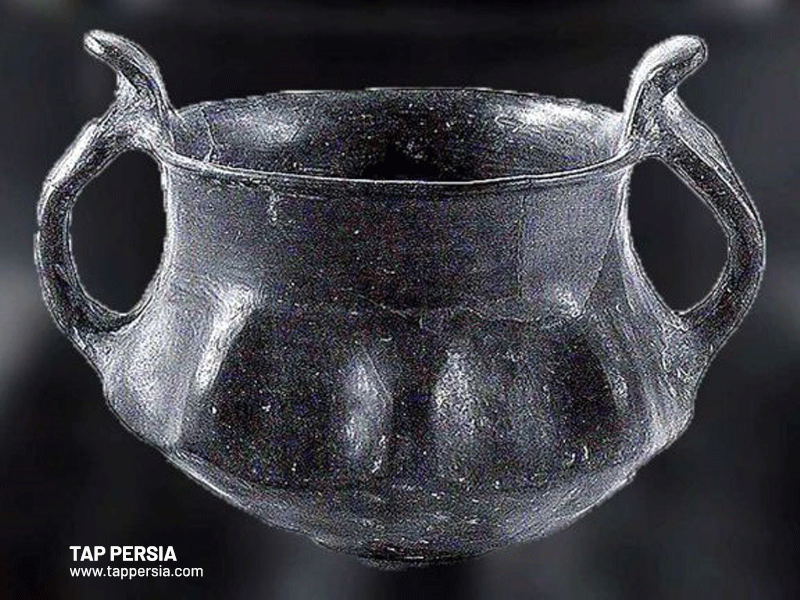
The Fifth Pottery Age: The Islamic Era
After the conquest of the Arab Umayyad dynasty over the Sassanid Empire, all aspects of Persian culture, including literature, art, and language, witnessed a drastic transformation. The art of pottery making in the Islamic period saw three significant chapters in the Samanid, Seljuk, and Safavid periods:
I. Pottery in Samanid Age: In the Samanid Era a special technique was introduced in pottery making known as “slip painting” in which semi-fluid clay (slip) was mixed with colors preventing the designs to get ruined while being heated. In The Samanid Era, the motifs of the Sasanian Dynasty were used in pottery design, including horsemen, birds, the heads of lions, and Arabic calligraphic patterns.
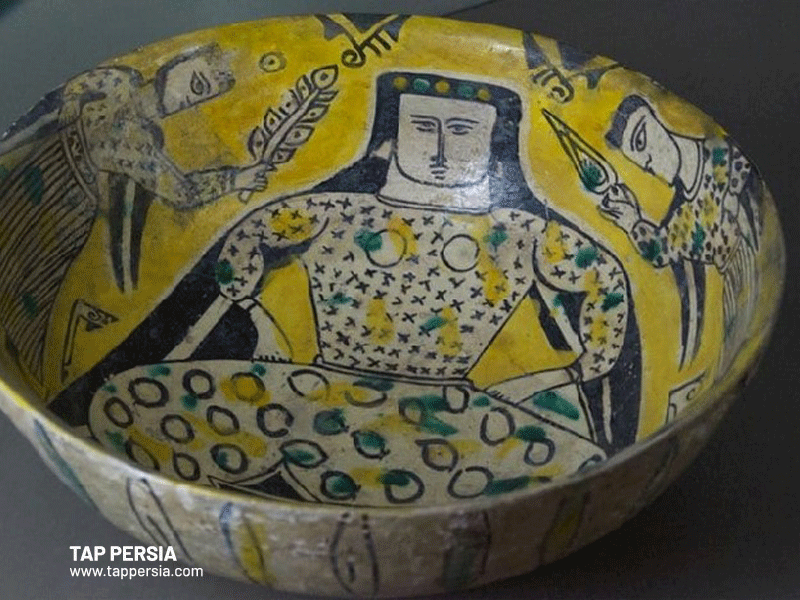
II. Pottery in the Seljuk Empire: Persians during Seljuk Empire produced the most celebrated pottery dishes in the history of Persian pottery. Kashan was the center of pottery production in Iran developing the three main types of pottery dishes, including lusterware, underglaze painted ware and polychrome overglaze painted mina’i ware. The golden era of fine pottery in Iran came to an abrupt end with the Mongol invasion of Iran.
Only decades after the invasion, Mongol pottery masters showed interest in the art of developing fine art and pottery dishes which resumed the art of pottery making in Iran.
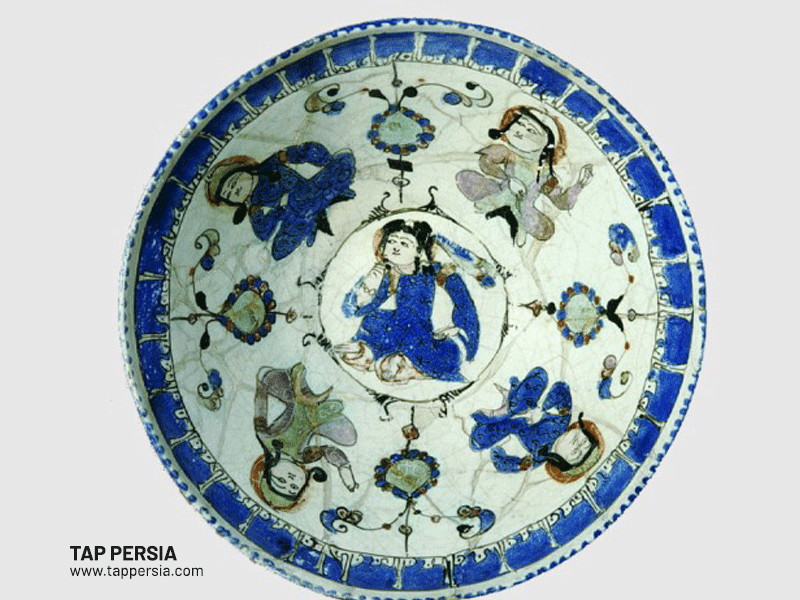
Pottery in Safavid Era: The Safavid Empire that lasted for two centuries saw one of the greatest chapters of Persian art, a great large portion of which was unfortunately lost during the era and was not preserved for the next generations. Lisa Golombek et al. in Persian Pottery in the First Global Age: The Sixteenth and Seventeenth Centuries introduce the following features to recognize Safavid pottery:
• Peach Blossom
A grouping of two large abutting fruits, sprouting antenna-like leaves above, is repeated at intervals around the exterior walls of the dish. Two-pronged tendrils expand to either side. The peach plant occurred earlier in the cavetto of Precise wares. (…) The motif is ultimately derived from the Chinese peach blossom of early Ming porcelain. (219)
• Grassy Plants
The underside of the cavetto is decorated with two large plants. In one variation the key components involve arching grasses, particularly iris or prunus-flowered grasses, sprouting from the baseline in opposite directions. (…) On all of the dishes within this group, the grassy plants mirror each other on either side of the dish exterior with bird or insect motifs in between. Landscape elements, suggesting rock formations or fungus motifs, appear along the baseline of the border. (220)
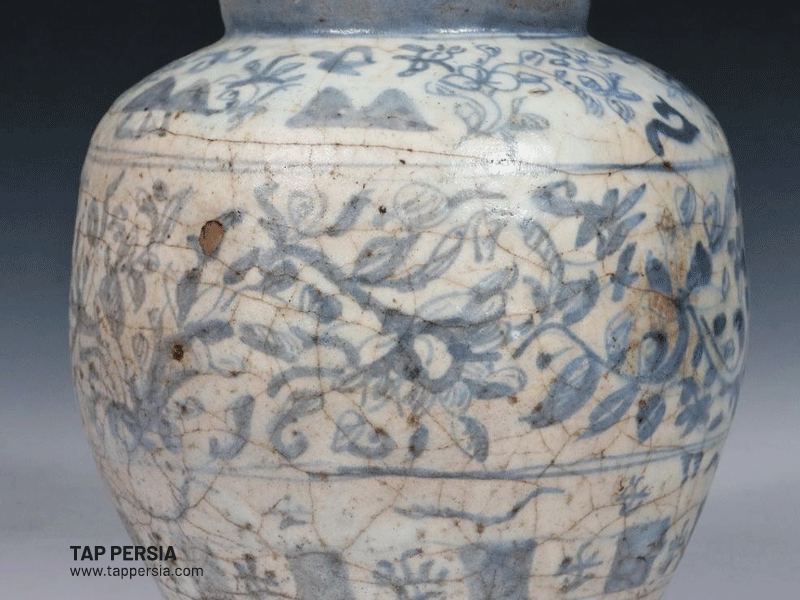
• Tree Branches
This design also places two similar forms of foliage on either side of the underside of the dish’s cavetto region. However, grass foliage is replaced by vine-like branches usually with a bird sitting on them. This was a common exterior design for Chinese porcelain dishes of the late sixteenth century. (…) The Persian examples closely follow the Chinese and normally do not insert additional landscape details. (220)
• Continuous Lotus Scrolls
Early examples of the lotus scroll closely follow the Yuan models. (…) From the undulating stem of the vine grow lotus blossoms with pointed petals and large-lobed leaves in the form of elongated triangles with points. The fine detail of the lotus scroll is typical of Kirman’s “boutique” production around 1630. (222)
Multiple patterns exist in the pottery dishes that were created in the Safavid era. The most important factor that should be taken into consideration while studying pottery in the Safavid era is that Persian potteries were mostly influenced by Chinese proclaim art in the Ming and Yuan Dynasties.
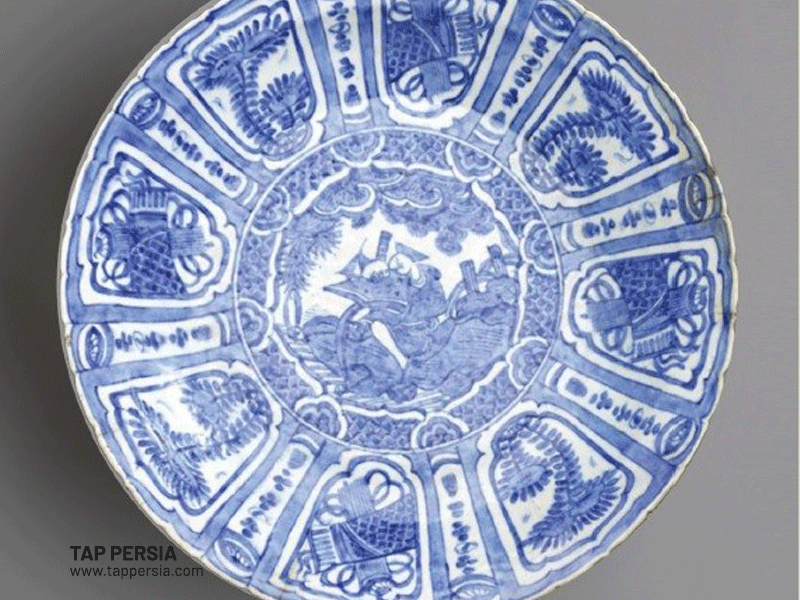
A Safavid pottery dish that has accurately copied the Chinese model.

The resemblance of the Chinese style in a Safavid pottery dish.
Persian Pottery in Modern Times
The contemporary art of pottery in Iran has managed to continue its remarkable legacy while developing it even further in some regions of Iran. In the following, we will discuss the art of pottery making in some of the major cities of Iran.

I. Meybod, a city in Yazd:
Meybod is considered the center of pottery dishes in Iran and is also known as the “Pottery Capital of Iran.” The patterns on the pottery dishes in this area are influenced by the climate, desert, sky, water, etc. Two of the most significant patterns on Meybod pottery dishes are “The Lady Sun” and “The Bird and the Fish”. The sun resembles the sunny climate of the desert in which Yazd is located and the fish represent the draught and the water shortage in the area.
II. Semnan:
The pottery dishes made in Semnan rate the top second in terms of quality in Iran. Semnan pottery-making industry incorporates the modern approaches in pottery with the national and ancient themes resulting in eye-catching pieces of art.
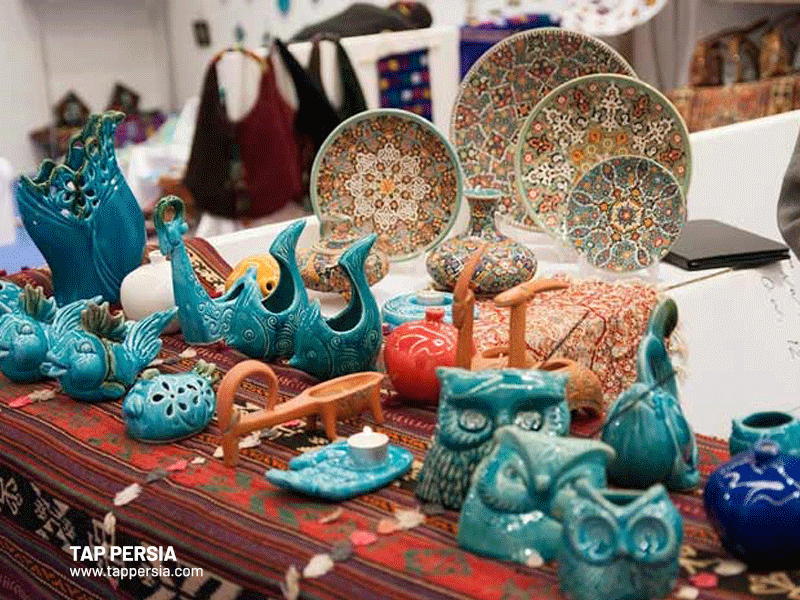
III. Shahr-Reza a city in Isfahan(Iranian pottery):
In the countryside of Isfahan, the entire ground is filled with red dirt which is in fact clay, the essential material for pottery making. Isfahan, which was at some point the capital of Iran during the Safavid era, is home to various aspects of ancient Persian art of which pottery is only one. The art of pottery making in Isfahan follows a special pattern and technique that is represented in the picture.
IV. Kalpourgan village in Sistan and Baluchistan:
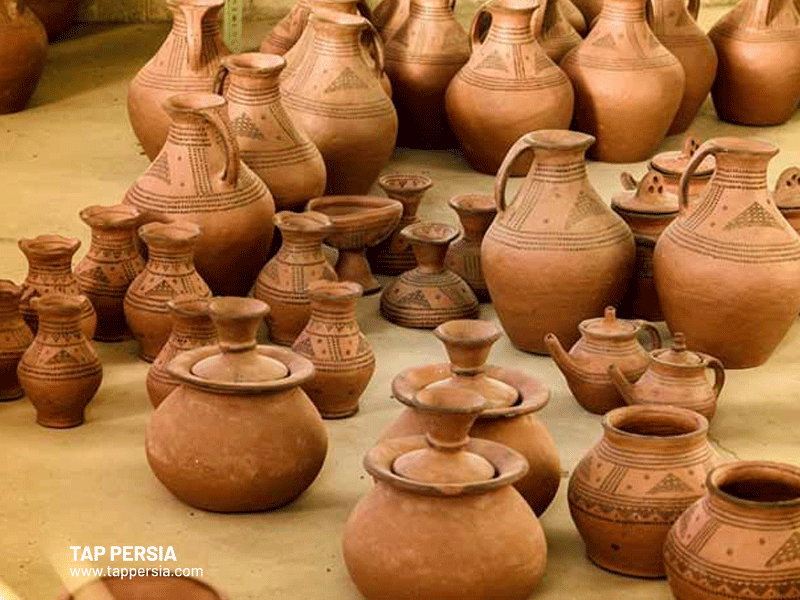
V. Kalpuregan, The Only Living Persian Pottery Persian Museum in the World

Kalpuregan is an ancient village, 25 kilometers away from Saravan, Sistan and Baluchestan Province. Based on many shreds of evidence, the art of pottery in this village is 7000 years old, and surprisingly this art has not changed through all these years. This means they don’t use Pottery machines and it is purely handmade. The pottery of Kalpuregan is quite distinct from other parts of Iran because of the magnificent manufacturing process and its magical color.
The history of living in this region dates back to about 10 thousand years old and the Pictograph and Petroglyphs of Saravan, the largest known petroglyphs in Iran, proves this fact. Kalpuregan, a small village with only 300 people, is the first village in Asia that is named on the UNESCO world heritage list. Majority of the people are farmers and their main products are dates, citrus fruits, and vegetables. However, the only feature that distinguishes Kalpuregan from the rest of Iran is its pottery, which remains intact, since about seven thousand years ago.
Jay Gluck, in his famous book “A Survey of Persian Handicraft” mentions Kalpuregan along with northern Thailand and Japan as the three main origins of the innovation of pottery. Unlike other parts of Iran that pottery is usually crafted by men, the history of Kalpuregan pottery belonges to women, because men were hunting or farming, and according to historical evidence, women were the cultivators of pottery art.
The pottery of Kalpuregan has unique features, as mentioned before, every part of the manufacturing process is handled by women. There are no glazes and the patterns and designs of Kalpuregan pottery are geometrical. These features remind us of ancient patterns and that is what makes them so valuable.
In the heart of Kalpuregan, there is the Kalpuregan Clay Living Museum which was made during the Pahlavi dynasty. In this place, rural women sit and make pottery. Without a pottery wheel, with an empty hand, and sometimes with a piece of wood for finishing touches. It usually takes a week for each piece of clay to turn into pottery. In this living Museum, they teach you how to make pottery and you can build your own. If you have enough time you can wait a few days, and they will bake your artwork and hand it to you.
Building your own pottery with your own hands is an incredible experience. You will never forget this memorable and exciting moment, and you can only enjoy it in Kalpuregan.
Handicrafts made from clay are commonly called a pottery. Among the oldest industries in human history, pottery is one of the oldest. Almost everywhere in Iran, you can find pottery, with Iranians making pottery and other goods. The pottery industry in Shiraz accounts for one of the most important types of goods which can be purchased when buying a souvenir. Additionally, people in Shiraz also make pottery, making it an interesting and special kind of art.
Pottery; Art of Making Clay Objects.

It is said that pottery is the craft of making vessels from moist mud, and the resulting vessel is called pottery. The pottery jars and cups are perhaps the most famous ones. Before glass was invented, pottery was the most common human handicraft.
The best soil for the pottery industry is clay, which is red because of the high iron content. Humans have been engaged in pottery-making since the dawn of civilization.
All Kinds of Clay
It is well known that clay plays an important role in the making of pottery. There are different types of clay, each of which is used for a specific type of pottery.
Kaolin or Kaolin
These white clays are often utilized in the manufacturing of porcelain dishes.
Bole Clay
There are many different colors and shades of this clay, including pale yellow to black. This type of clay is also used in making ceramic dishes, especially porcelain.
Fireclay
A container made of this type of clay is resistant to high temperatures and fire, and will not crack or break.
Adobe Clay
This type of clay is common and it is a versatile material. Lots of ordinary pottery is made out of this clay.
Ceramic

Most of the pottery that you take with you from Shiraz as souvenirs are made of ceramics, which are very colorful and attractive(Shiraz souvenirs). The word ceramic is derived from the Greek word “Keramika” which means “from pottery”.
A ceramic is a material produced from mixing clay and sand, covering its surface with glaze and heating it to a very high temperature, which then becomes hard, dense, and almost impermeable to a great extent. About 5,000 years ago, people discovered that it was possible to waterproof, paint, and decorate pottery and tiles. Porcelain tiles and utensils are common examples of ceramics. These materials are famous for use in construction, industry, and art.
Historical Pottery Inscriptions of Shiraz

The clay inscriptions of Persepolis Shiraz are one of Iran’s most important pieces of pottery. This collection of tablets gives us one of the few reliable sources for understanding how the Achaemenid state worked internally and their laws, 2500 years ago.
A historical account of political, social, and economic affairs, including the rights and obligations of the Achaemenid kings.
In these tablets has been proven that Persepolis and other Achaemenid palaces, unlike other great structures of the kings of that time, were built by free masters and workers and were not used in their construction under other pretexts.
There is much detail in the inscriptions about the rights and rewards that were given to workers at that time. There is remarkable evidence from the clay tablets discovered from Persepolis that there were also female workers and masters among those responsible for the construction of the building.
The women earned the same amount as men and could take paid leave to give birth to their children and breastfeed their babies. Human rights were observed in Iran thousands of years ago through Persepolis clay tablets.
Pottery Museum in Shiraz
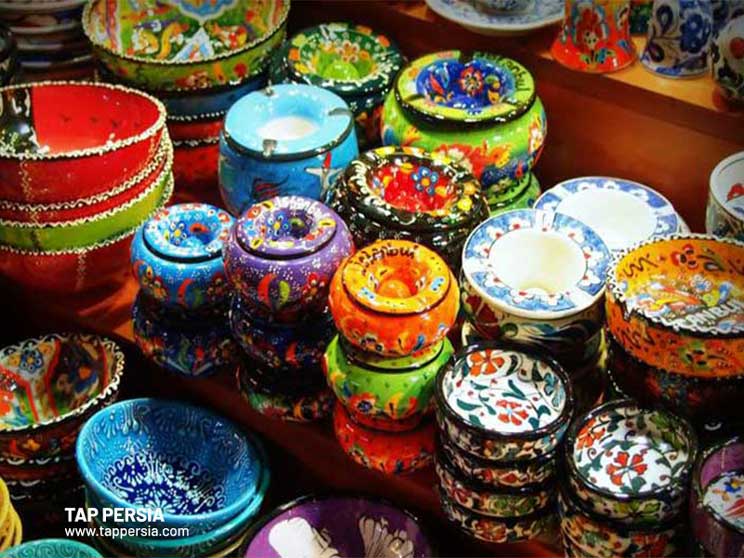 Shiraz has many ancient pottery ruins dating back much further, the oldest of which dates back to 2500 years ago when the Achaemenid Empire ruled Iran. Various types of pottery from different times have been stored in old mansions that have been turned into museums in Shiraz.
Shiraz has many ancient pottery ruins dating back much further, the oldest of which dates back to 2500 years ago when the Achaemenid Empire ruled Iran. Various types of pottery from different times have been stored in old mansions that have been turned into museums in Shiraz.
There is an important source for the preservation of this pottery which dates back to the imperial period of Iran, the basement of Narenjestan Ghavam, which is now converted into a museum containing extensive collections of antiques, particularly pottery.
Benefit of Pottery
Pottery has unique features and advantages, including the following:
Being in contact with clay is a soothing sensory experience, and it creates a relaxed state of mind. Making pottery can be a fun, enjoyable activity with friends during spare time.
You can nurture your creative talents or also ease stress by doing pottery, which is considered to be a good exercise for the mind and body. Making ceramics will increase your self-confidence and make it possible for you to believe in your abilities.

Don’t Forget to Buy Souvenirs
People living in Shiraz continue to appreciate the importance of pottery. Decorative pottery objects, earthenware vases, and even ceramics pitchers are still seen in many homes today. The Shiraz pottery offers tourists an excellent souvenir to take home.
Iranian pottery making art is significant in this region since the pottery items are only handcrafted by women. Men only help in the process of carrying the clay and nothing more. The most significant aspect of the art of pottery making in this region is that it has kept the ancient motifs.
The artifacts that are created in this region at present almost resemble the artworks that were created thousands of years ago. A special stone called “Tituk” is used in enameling the pottery dishes from this region.
In this article, we have provided a brief introduction to the art of pottery making in Iran, from ancient times to the present. Some of the most significant ages in the pottery-making industry in Iran were introduced and the significant aspects of pottery dishes in those eras were briefly detailed.
After expounding on the art of pottery, in the pre-Islamic era in Persia, we discussed the three most significant chapters in the art of pottery making in Iran after the Islamization of Iran. Then, we shifted our focus to the present times and expounded on the contemporary art of pottery making in multiple regions of Iran.
As previously stated, ceramic is any item that is created under pressure at high temperatures. The most significant use of ceramics in Iran was the use of ceramic tiles that would cover the buildings’ walls in the Safavid era.
The paintings on the ceramic tiles in the Safavid era introduce a great chapter in the Persian ceramics arts. A great example is the following tile:
This tile is thus an important document in that it provides a place of manufacture, a date, a possible place of origin for the maker or commissioner (i.e., Abarquh, lying between Isfahan and Yazd), and some diagnostic decorative motifs.

These motifs appear on a series of dated funerary tiles, and the potters named on these tiles have nisbahs from the Yazd region (Ardakan);14 tiles in this series bear the following dates: 957/1550, 959/1551, 960/1553, 967/1560. Although not of high artistic value, these tiles represent the earliest evidence (of) a workshop in the Isfahan region (that) was closely linked with the style of the painter Riza Abbasi in the early seventeenth century. (Golombek et al. 173)
The renowned painter Riza Abbasi who lived during the reign of Shah Abbas in the Safavid Empire also provides examples of pottery art during the Safavid era in his tile paintings.
As it is observed in the tile painting, the woman is carrying a pottery dish that gives a clear insight into the patterns and materials used in the pottery-making industry during the Safavid era. Unfortunately, none of this specific type of pottery has survived to the present age.
The art of Persian pottery and ceramics spans thousands of years, a brief chapter of which was provided in this article. If you want to learn more about the art of pottery and ceramics in the Safavid era in Iran, follow this link and download the book.
References:
Golombek, Lisa, Mason, Robert B., Proctor, Patricia, and Eileen Reilly. (2013). Persian Pottery in the First Global Age: The Sixteenth and Seventeenth Centuries. Brill.


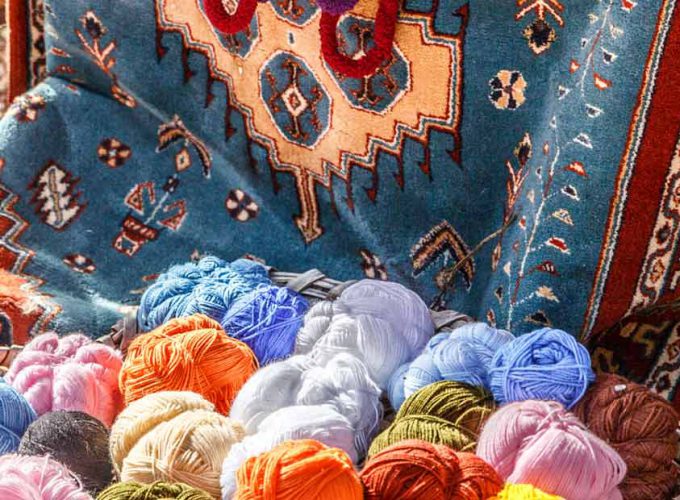
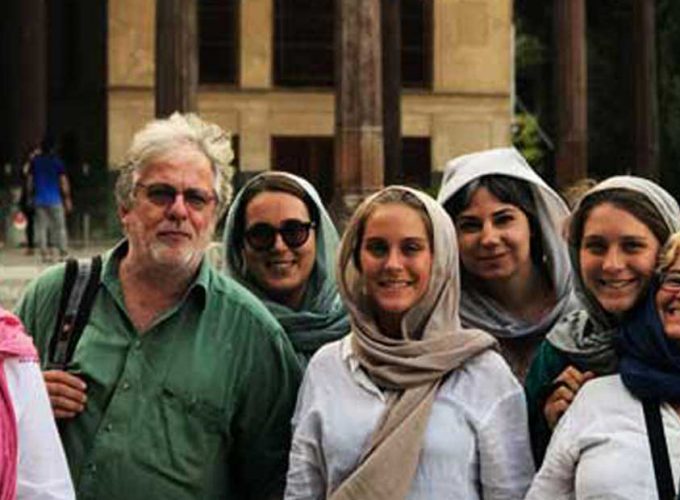






Comment (0)